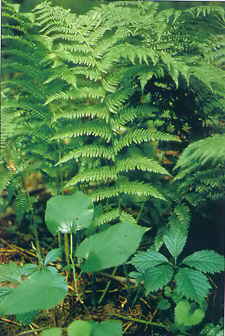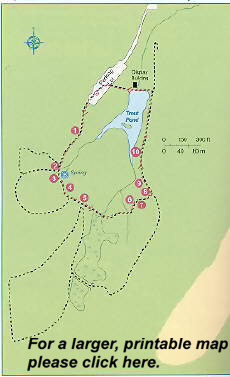Sassafrass Tour
If you are looking for a quiet place, an oasis of solitude, where you can commune with nature and escape the hectic, stressful pace of our modern society, you have no further to go than the St. Johns Conservation Area. This secluded forest area, nestled in the Short Hills, offers the perfect retreat for nature lovers, hikers, bird watchers, and fisherman.
Tucked into this relatively small area (31 hectares; 76 acres ) are trees and shrubs of the Carolianian forests normally found in the eastern and south-eastern United States rather than this far north. Because this area has never been farmed or developed, you will see rare species and trees that are over 200 years old.
But the jewel of this conservation area is a large pond whose still waters teem with trout. Built in 1964 to regulate the flow of water into Twelve Mile Creek, the stocked pond serves as a trout fishery and is jealously guarded secret amongst local anglers.
The Sassafras Stroll is a self-guiding nature trail that is named after the Sassafras tree that grows abundantly in this conservation area. The loop, which is over flat terrain, is shown in Map 15 and can be completed in as little as twenty minutes.
The trail begins at the southwest end of the parking lot and has ten stops that are briefly summarized below and are shown on the Map above.

- 1. The many shrubs in this area provide food and cover for various species of birds including scarlet tanagers, rofous-sided towhees, thrushes, catbirds, and warblers.
- 2. This small pond fills a former gravel pit and is fed by a natural spring.
- 3. To the left of the trail (east side is a forest in a young growth stage, while on the right is a mature (Maple-Beech clIMAX) forest. The trees in the young forest are smaller and allow more light to penetrate. This stimulates growth of ground cover plants that attract birds and animals.
- 4. This stop features a small tangled clearing of grapevines. The vines grow up support trees which eventually die, creating the clearing.
- 5. Many small sassafras trees are located here. The leaves have a spicy odour when crushed, and Sassafras tea can be made from the bark or the roots.
- 6. The forest floor is home to fungus, moulds, mushrooms, and toadstools as well as insects such as spiders, ants, beetles. It takes about 1,000 years to make one inch of soil from the fallen leaves and branches.
- 7. The Rough Horsetail, the most primitive member of the fern families, is found here. It does not have flowers, leaves, seeds, or true roots.
- 8. Several species of ferns can be seen here. Ferns are unlike any other green plants in that they do not have flowers and , therefore, cannot reproduce by seeds.
- 9. The St. Johns are contains trees typical of the Carolinian zone such as sassafras; tulip tree; black, pin, white, and red oak; black cherry; shag bark hickory; butternut and flowering dogwood. Also found here are red and sugar maples, white pines, eastern hemlock, and American beeches.
- 10.The trout pond contains not only trout, but also a variety of animal and plant life including common toads, spring peepers, flathead minnows, eastern painted turtles, and the green heron.




